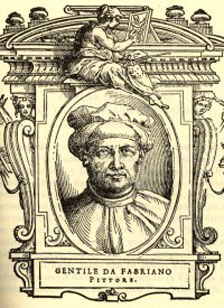| Gentile da Fabriano  AKA Niccolo di Giovanni di Massio AKA Niccolo di Giovanni di Massio
Born: c. 1370
Birthplace: Fabriano, Italy
Died: 1427
Location of death: Rome, Italy
Cause of death: unspecified
Gender: Male
Religion: Roman Catholic
Race or Ethnicity: White
Occupation: Painter Nationality: Italy
Executive summary: Italian Gothic painter Italian painter, born at Fabriano about 1370. He is said to have been a pupil of Allegretto di Nuzio, and has been supposed to have received most of his early instruction from Fra Angelico, to whose manner his bears in some respects a close similarity. About 1411 he went to Venice, where by order of the doge and senate he was engaged to adorn the great hall of the ducal palace with frescoes from the life of Barbarossa. He executed this work so entirely to the satisfaction of his employers that they granted him a pension for life, and accorded him the privilege of wearing the habit of a Venetian noble. About 1422 he went to Florence, where in 1423 he painted an "Adoration of the Magi" for the church of Santa Trinita, which is preserved in the Florence Accademia; this painting is considered his best work now extant. To the same period belongs a "Madonna and Child", which is now in the Berlin Museum. He had by this time attained a wide reputation, and was engaged to paint pictures for various churches, more particularly Siena, Perugia, Gubbio and Fabriano. About 1426 he was called to Rome by Pope Martin V to adorn the church of St. John Lateran with frescoes from the life of John the Baptist. He also executed a portrait of the pope attended by ten cardinals, and in the church of St. Francesco Romano a painting of the "Virgin and Child attended by St. Benedict and St. Joseph", which was much esteemed by Michelangelo, but is no longer in existence. Gentile da Fabriano died about 1450. Michelangelo said of him that his works resembled his name, meaning noble or refined. They are full of a quiet and serene joyousness, and he has a na´ve and innocent delight in splendor and in gold ornaments, with which, however, his pictures are not overloaded.
Do you know something we don't?
Submit a correction or make a comment about this profile
Copyright ©2019 Soylent Communications
|